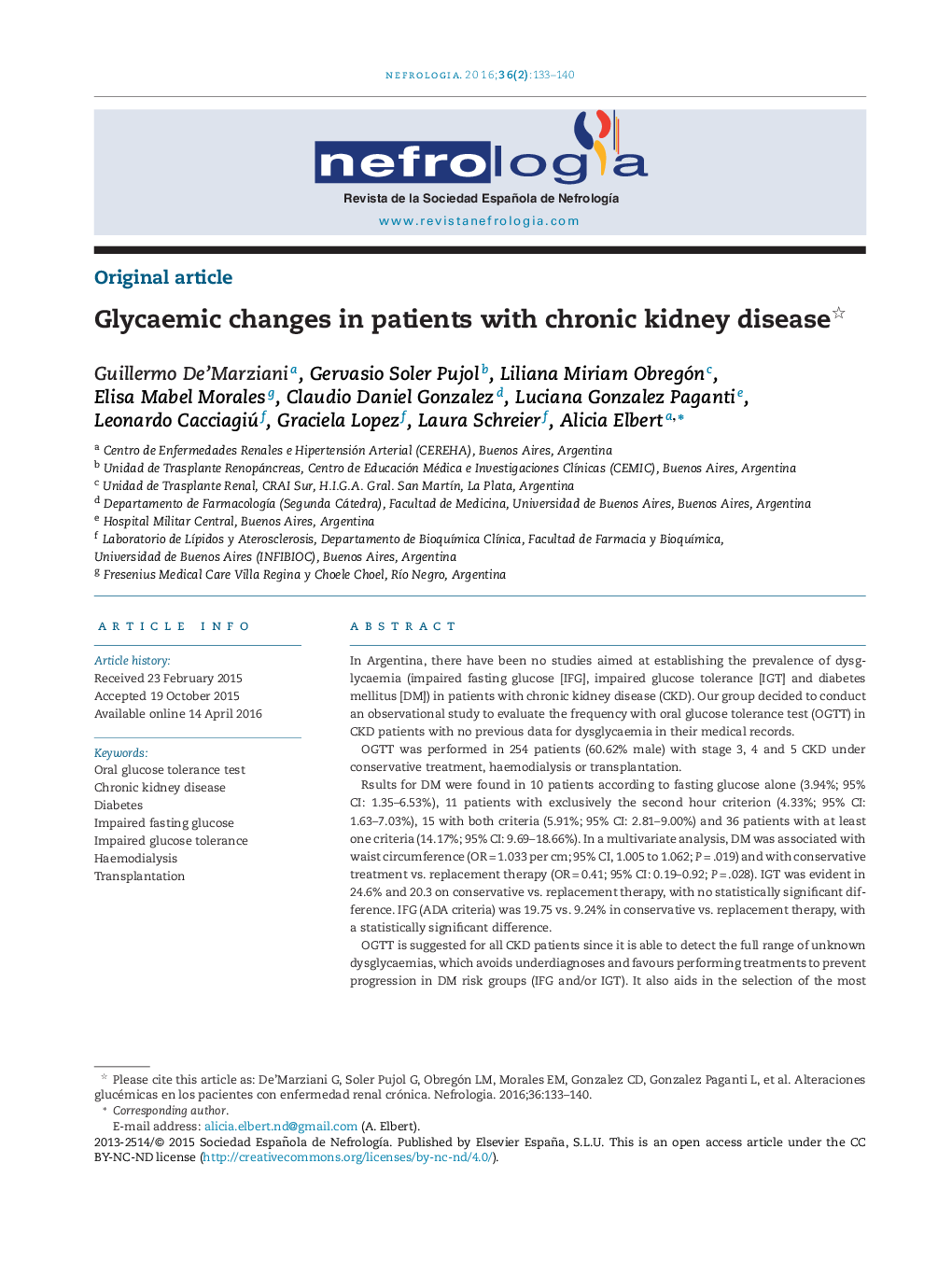| کد مقاله | کد نشریه | سال انتشار | مقاله انگلیسی | نسخه تمام متن |
|---|---|---|---|---|
| 3892643 | 1250078 | 2016 | 8 صفحه PDF | دانلود رایگان |

In Argentina, there have been no studies aimed at establishing the prevalence of dysglycaemia (impaired fasting glucose [IFG], impaired glucose tolerance [IGT] and diabetes mellitus [DM]) in patients with chronic kidney disease (CKD). Our group decided to conduct an observational study to evaluate the frequency with oral glucose tolerance test (OGTT) in CKD patients with no previous data for dysglycaemia in their medical records.OGTT was performed in 254 patients (60.62% male) with stage 3, 4 and 5 CKD under conservative treatment, haemodialysis or transplantation.Rsults for DM were found in 10 patients according to fasting glucose alone (3.94%; 95% CI: 1.35–6.53%), 11 patients with exclusively the second hour criterion (4.33%; 95% CI: 1.63–7.03%), 15 with both criteria (5.91%; 95% CI: 2.81–9.00%) and 36 patients with at least one criteria (14.17%; 95% CI: 9.69–18.66%). In a multivariate analysis, DM was associated with waist circumference (OR = 1.033 per cm; 95% CI, 1.005 to 1.062; P = .019) and with conservative treatment vs. replacement therapy (OR = 0.41; 95% CI: 0.19–0.92; P = .028). IGT was evident in 24.6% and 20.3 on conservative vs. replacement therapy, with no statistically significant difference. IFG (ADA criteria) was 19.75 vs. 9.24% in conservative vs. replacement therapy, with a statistically significant difference.OGTT is suggested for all CKD patients since it is able to detect the full range of unknown dysglycaemias, which avoids underdiagnoses and favours performing treatments to prevent progression in DM risk groups (IFG and/or IGT). It also aids in the selection of the most appropriate medication for transplantation or treatment initiation in new cases of undiagnosed DM to decrease morbidity and mortality.
ResumenEn Argentina no se han realizado estudios destinados a establecer la prevalencia de disglucemias (glucemia alterada en ayunas [GAA], tolerancia alterada a la glucosa [TAG] y diabetes mellitus [DM]) en pacientes con enfermedad renal. Se decidió realizar un estudio observacional, evaluando la frecuencia con prueba de tolerancia oral a glucosa (PTOG) en pacientes con enfermedad renal crónica (ERC), sin registro de disglucemia en sus historias clínicas.Se realizó PTOG a 254 pacientes (60,62% masculinos), con ERC estadios 3, 4 y 5, en tratamiento conservador, hemodiálisis o trasplante.Los resultados mostraron pacientes con valores de DM: 10 pacientes según ayunas exclusivamente (3,94%; IC 95%: 1,35-6,53%); exclusivamente segunda hora, 11 pacientes (4,33%; IC 95%: 1,63-7,03%); por ambos criterios, 15 pacientes (5,91%; IC 95%: 2,81-9,00%); por al menos un criterio, 36 pacientes (14,17%; IC 95%: 9,69-18,66%). En análisis multivariado, la DM se asoció con valour de cintura (OR = 1,033 por cm; IC 95%: 1,005-1,062; p = 0,019) y con tratamiento sustitutivo vs. conservador (OR = 0,41; IC 95%: 0,19-0,92; p = 0,028). La GAA (criterio ADA) fue del 19,75% en tratamiento conservador vs. 9,24% en tratamiento sustitutivo, con diferencia estadísticamente significativa. No fue significativa la diferencia de TAG que evidenció 24,6 y 20,3% en tratamiento conservador y sustitutivo, respectivamente.Se propone la realización de PTOG en todo paciente con ERC, ya que permite la detección de todo el rango de disglucemias desconocidas, evitando el subdiagnóstico y favoreciendo la realización de tratamientos para evitar su progresión, en caso de estar ante la presencia de un grupo de riesgo para DM (GAA o TAG), así como la elección de la medicación más adecuada para el trasplante o el inicio del tratamiento de nuevos casos de DM no diagnosticada, para disminuir la morbimortalidad.
Journal: Nefrología (English Edition) - Volume 36, Issue 2, March–April 2016, Pages 133–140